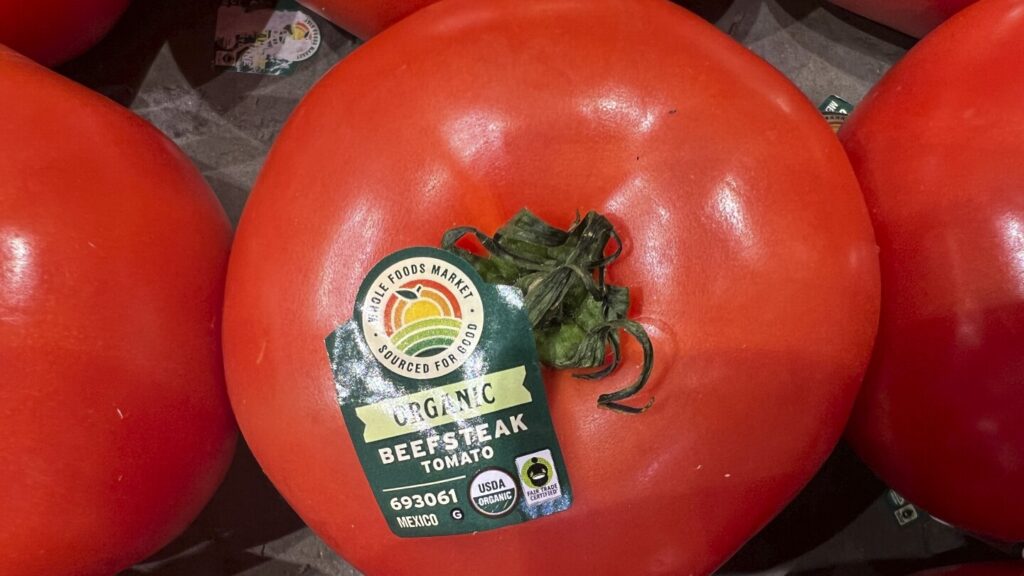Guacamole has been spared from tariffs for now. But salsa may not be so lucky.
While threatened tariffs on Mexican avocados have been put on pause, the U.S. government plans to put a nearly 21% duty on fresh Mexican tomatoes starting July 14. A duty — like a tariff — is a tax on imports, and this one will impact the 4 billion pounds of tomatoes the U.S. imports from Mexico each year.
Proponents say the duty will help rebuild the shrinking U.S. tomato industry and ensure that produce eaten in the U.S. is also grown there. Mexico currently supplies around 70% of U.S. tomato market, up from 30% two decades ago, according to the Florida Tomato Exchange, a trade group.
“Unless we even the playing field in terms of fair pricing, you’re not going to have a domestic industry for fresh tomatoes in the very near future,” said Robert Guenther, the executive vice president of the Florida Tomato Exchange. Florida and California are the top U.S. producers of tomatoes, but most of California’s crop is turned into sauces and other products.
Opponents say the duty will make fresh tomatoes more expensive for U.S. buyers. NatureSweet, a San Antonio-based company that grows tomatoes in Mexico as well as the U.S., said it will be paying millions of dollars each month in duties if the decision isn’t reversed.
“We will look for ways to adapt or streamline our operations, but the truth is, we are always doing that so we run an efficient business already,” said Skip Hulett, NatureSweet’s chief legal officer. “Produce is not a large-margin business. We’re determining what portion of the cost we could absorb, but these added costs will most certainly need to be passed on to the consumer.”
Tim Richards, a professor at the Morrison School of Agribusiness at Arizona State University, expects U.S. retail prices for tomatoes to rise by around 10.5% if the tariffs go through.
Mexico’s government said last month it was convinced it could negotiate over the issue. But if the duty goes into effect, Mexican President Claudia Sheinbaum hinted that Mexico could take similar action against imported chicken and pork legs from the U.S.
The tug-of-war over tomatoes has a long history. In 1996, shortly after the North American Free Trade Agreement went into effect, the U.S. Department of Commerce investigated allegations that Mexico was exporting tomatoes to the U.S. at artificially low prices, a practice known as dumping.
The U.S. government agreed to suspend the investigation if Mexico met certain rules, including selling its tomatoes at a minimum price. Since then, the agreement has been subject to periodic reviews, but the two sides have always reached an agreement that avoided duties.
But last month, the Commerce Department announced its withdrawal from the latest agreement, saying it has been “flooded with comments” from U.S. tomato growers who want better protection from Mexican imports.
Guenther, of the Florida Tomato Exchange, said even though Mexican exporters are required to charge a minimum price, shipments are only spot-checked, so exporters can get around that. But more generally, Mexico hurts the U.S. industry because it costs 40% to 50% less to grow tomatoes there, Guenther said. Land is cheaper, labor is cheaper and inputs like seeds and fertilizer cost less, he said.
Tomatoes are a labor-intensive crop, Guenther said, and the U.S. industry typically relies on immigrant workers through the H-2A visa program. That program required farmers to pay workers an average of $16.98 per hour last year, an amount that has jumped as labor has become harder to find. Richards estimates that workers on Mexican tomato farms earn about one-tenth that rate.
NatureSweet acknowledges that it’s more cost-effective to grow tomatoes in Mexico, but says climate is one of the biggest reasons. The company’s Mexican greenhouses don’t need lighting, heating or cooling systems because of the year-round weather conditions.
“You can relocate some industries, but you can’t relocate climate agriculture,” Hulett said.
Lance Jungmeyer, the president of the Fresh Produce Association of the Americas, which represents importers of Mexican tomatoes, said Florida doesn’t produce the vine-ripened tomatoes that U.S. consumers increasingly favor. Florida tomatoes are picked when they’re green and shipped to warehouses to ripen, he said.
“Florida doesn’t grow the kinds of specialty tomatoes that have taken off, but they want to get protection,” Jungmeyer said. “Their market share is dropping for reasons of their own choice.”
Guenther disagrees. “If you put a Florida tomato up against a Mexican tomato, I think it would do very well in taste test,” he said.
Adrian Burciaga, co-owner of Don Artemio, an upscale Mexican restaurant in Fort Worth, Texas, wouldn’t want to switch to a U.S. producer. He compares it to fine wine; if he wants a good cabernet sauvignon, he gets it from Napa, California, but if he wants a good tomato that remind him of his childhood, he gets it from Mexico.
“We know the flavors they are going to bring to the salsas and moles. We don’t want to compromise flavors,” Burciaga said.
Burciaga said his restaurant uses 300 to 400 pounds of Roma tomatoes from Mexico every week. He currently pays $19 for a 25-pound crate of tomatoes. He doesn’t relish paying the additional cost, but he feels he has no choice.
Burciaga said the tomato duty and the threat of other tariffs against Mexico – which were put in place in February but then paused – are making it difficult to run his business.
“The uncertainty part concerns us. A small or medium restaurant budgets things out. We know in advance that in six months things will increase, so we’re able to adjust,” he said. “But we don’t know these things in advance. How do you plan and how do you react?”
___
AP Reporter Maria Verza in Mexico City contributed.
Read the full article here


